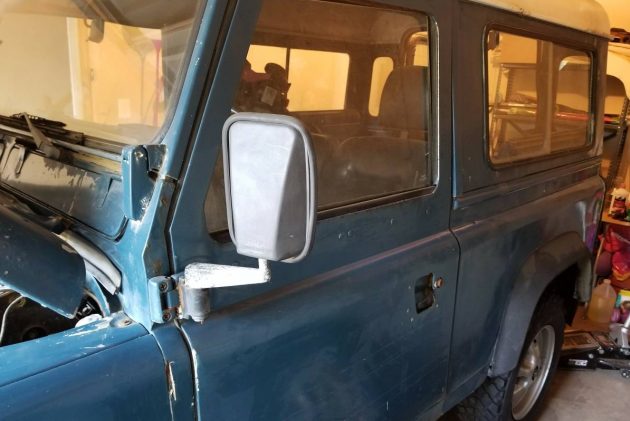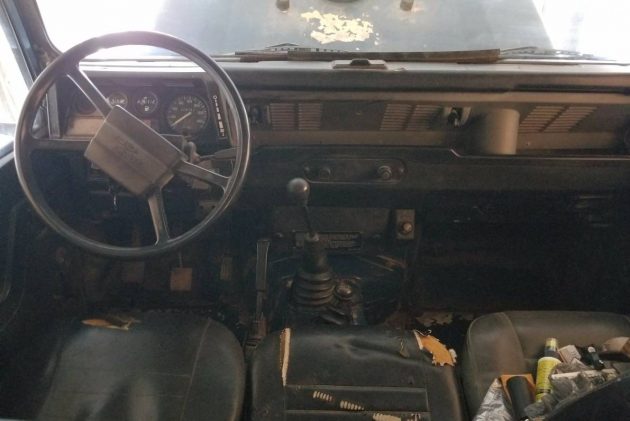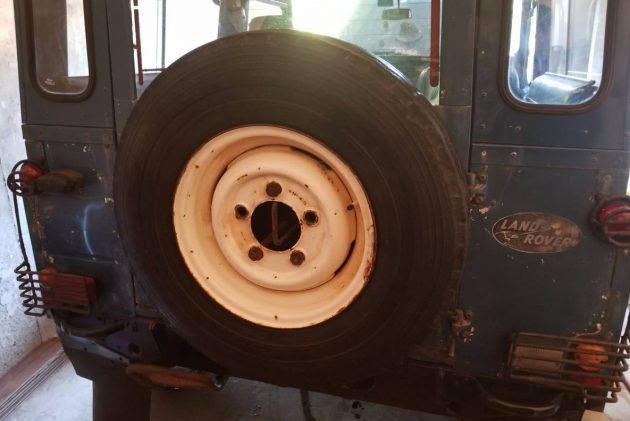If you’re like me, you’ve dreamed of bouncing along tree lined mountain trails in a classic Defender – but the recent prices of even the rustiest examples are scarier than their lack of safety accessories. Now, after spending its formative years in Italy, this one landed stateside last month. Found here on craigslist, this 1984 Defender 90 is a reasonable $14,500, with all original matching chassis and engine, according to the seller.
It’s got only 142k miles on the 2.5 4 banger Diesel – but like most Defenders, they can be pretty tough miles. Still, the body looks surprisingly solid, with rust in all the right places, and fewer dents and dings than you might expect. I’m not a fan of any model Land Rovers being squeaky clean, so I’d vote to fix the brakes (owner says they go to the floor), scrub it down, wash it out,treat anything plastic, and then repeat once a year.
I’m a diesel guy, and have had the joy of driving a few of these on fishing trips in Scotland, albeit more recent versions than this ’84. It features the 12-J engine (an early update during 11J to 15J series) whose heritage comes from 20,000 units bought by the British Army over a decade, and the only small capacity high-speed diesels to pass the Ministry of Defence’s arduous 500-hour durability trial. Most importantly, this diesel version was legendary for its torque after they lengthened the stroke (and as a bonus, it’s when they started to pass emissions tests!)
The owner say’s “This is an amazing truck…very rare…an eye-catching truck”, and I would agree. Even if it will only see blacktop and never hit a trail, this eye catcher D90 could very well be that Keeper you can drive off into the sunset in!






Price seems to have increased: the ad says $16,500.
I’ve driven a Defender — with the later Rover V8 — over the Rubicon Trail in California, and found it the equal of (or even better than) a Jeep for that kind of rock-crawling. The alloy body doesn’t fare well in such conditions, though, as bumps that might scuff the paint on a Jeep leave good-sized divots in the panels. Another Defender on the same run boasted similar scars, so it wasn’t just my ineptitude!
All that said, I think the seller is being a bit ambitious with the price. Aside from a small amount of corrosion and interior flaws, engine oil blow-by is mentioned, which might well indicate that a teardown is going to be necessary. If, that is, the engine is kept; the seller advocates replacing it if the new owner plans much highway use.
Unless the intent is to do lots of off-roading and an absolute minimum of daily driving, I’d give this Landie — or any other with an oil-burner under the hood — a miss. I suspect it’s more of a do-it-yourself kit than most people would like, unless they plan to spend a lot of time crawling through the boonies, which these do wonderfully well.
you go any where in the world these diesels and petrol rover are cheap as hell- once they hit the usa to price goes up 4 plus times what they are really worth – i just don’t get it- i’ve owned 5 -88- land rovers through the years and have loved them all- the BEST 4X4XFAR-! but to now pay 4 plus times what they are worth- NO- i just can’t and won’t do that-
everyone who owns these never use them for their intended purpose anyways,they end up being mall crawlers or soccer mom taxis—whata waste!
explore the paths and trails or make your own as i do-
capable and confident plus reliable on and off road too.
perhaps if you have more income than IQ this is a deal to someone…..however in my assessment this is a 4k purchase all day long-good luck to mr/ms new owner
the huge up side to these is there is every conceivable bit and spare available for this to maintain and or repair- unlike the japanese copies of an original-!
if everyone knew how these actually drove, the asking price would be much lower.
Also the old diesels are going to have trouble in the way of getting parts for the motor. I would not go less than 2-300tdi at this moment.
I just find it hard to believe that the Defenders are going for 10k+ and theres still a lot of work to do.
These cars don’t sell well, but there’s an ass for every seat. Patience is needed.
Since 1980 …
The chassis number is a series of 17 alphanumeric entries called VIN (SALLDVAF8HA470110 for example), except for NAS models for which the coding is different.
Entry 1> Origin of the brand: continent, S for Europe
Entry 2> Origin of the mark: country, A for Great Britain
Input 3> Manufacturer, L for Land Rover
Inputs 4 & 5> Type of model
LB for Series III
LD for 90,110,127 & Defender
LH for Range Rover Classic
LJ for Discovery
LN for Freelander
LM for Range Rover L322
LP for Range Rover P38
LT for Discovery Series II
Input 6> Model in type
A for Series III 88 ”
A for Defender 90 “extra heavy duty
A for Range Rover Classic 100 ”
A for Range Rover (38A) 108 ”
A for Freelander
B for Series III 88 “Lightweight
B for Defender 110 “extra heavy duty
B for Range Rover Classic LSE 108 ”
B for Freelander Commercial
C for Series III 109 ”
C for Defender 130 “extra heavy duty
D for Series III 109 “1 Ton
G for Discovery 100 ”
H for Defender 110 “standard
M for special chassis
K for Defender 130 ”
R standard for Defender 110″ 24 volt
S for Defender 90 “24 volt
V for Defender 90 “standard
Input 7> Body type
A for Basic (baché, pickup, hardtop VU)
A for Freelander 3 doors VU
A for Discovery 3 or 5 doors VU
B for Series III 88 “Station Wagon
B for Defender 3-door Station Wagon
B for Range Rover Classic 2 doors
B for Discovery 3 doors
B for Freelander 5 doors
F for Defender 4 doors Crewcab non HCPU
H for Defender HCPU Crewcab or not
M for Defender 5-door Station Wagon
M for Range Rover Classic 4 door
M for Range Rover (38A) 4 door
M for Discovery 5 door
R for Range Rover Montiverdi 4 doors
Input 8> Motor type
A for 1.8l, 4 cylinders in line, “K” series, high compression yoke, unleaded gasoline.
B for 2.5l, 4 cylinders in line, turbo-diesel, prefix 19J
B for 2.0l, 4 cylinders in line, “L” series, turbo-diesel
C for 2.5l, 4 cylinders in line, diesel, prefix 12J
C for 1.8l, 4 cylinders in line, “K” series, high compression yoke, unleaded gasoline.
D for 2.5l, 4 cylinder in line petrol, prefix 17H
D 1.8l, 4 cylinders in line, “K” series, high compression yoke, unleaded petrol.
E for 3.5l, V8 gasoline carburetor, high compression yokes
E for 2.4l, 4 cylinders in line, VM Diesel
E for 2.0l, 4 cylinders in line, BMW M47 (Td4) diesel
F for 2.5l, 4 cylinders in line, turbo-diesel (200Tdi / 300Tdi) without EGR nor catalyst, prefix 11L or 16L
F for 1.8l, 4 cylinders in line, “K” series, high compression yoke, unleaded gasoline.
G for 2.25l, 4 cylinders in diesel line
G for 2.5l, V6, “KV6” series, unleaded petrol
H for 2.25l, 4 cylinders in line, gasoline
H for 2.5l, V6, “KV6” series, leaded gasoline
J for [ul] 4.6l, V8 EFI petrol
J 2.5l, V6, “KV6” series Ethanol
L for 3.5l, V8 EFI petrol
M for 4.0l, V8 EFI petrol
N for 2.5l, 4 cylinders in line, VM Diesel
P for 2.6l, 6 cylinders in line gasoline
V for 3.5l, V8 carbs esence, low compression heads
W for 2.5l, 6 cylinder inline BMW diesel
Y for 2.0l, 4 cylinders in-line MPI gasoline
1 for 4.0l, V8 EFI, catalyzed low compression
2 for 4.0l, V8 EFI, High Compression Catalyzed
3 for 4.0l, V8 EFI, low uncatalyzed compression
5 for 2.5l, 5 cylinders in line, turbo-diesel (Td5)
6 for 2.5l, 4 cylinders in line, turbo-diesel (200Tdi / 300Tdi) with catalyzed EGR
7 for 2.5l, 5 cylinders in line, turbo-diesel (Td5)
8 for 2.5l, 5 cylinder inline turbo-diesel (Td5) with EGR
9 for 2.5l, 5-cylinder in-line, turbo-diesel (Td5) with uncatalyzed EGR (Disco II)
9 for 2.8l, 6 cylinder in line, BMW “M52” petrol
Entry 9> Gearbox & driving side
1 for Series III 4-speed / right-hand drive
1 for LT95 4-speed / right-hand drive
1 for JATCO 5-speed automatic / right-hand drive
2 for Series III 4-speed / left-hand drive 2 for LT95 4-speed / left-hand drive
2 for JATCO 5-speed automatic / left-hand drive
3 for Chrysler 747 3-speed automatic / right-hand drive
3 for ZF 4-speed automatic / right-hand drive
4 for Chrysler 747 3-speed automatic / left-hand drive
4 for ZF 4-speed / left-hand drive
5 for LT95 4-speed with overdrive / right-hand drive
6 for LT95 4-speed with overdrive / left-hand drive
7 for 5-speed LT77 / right-hand drive
7 for LT77S 5-speed / right-hand drive
7 for LT85 5-speed / right-hand drive
7 for R380 5-speed / right-hand drive
7 for PG1 5-speed / right-hand drive
8 for LT77 5-speed / left-hand drive
8 LT77S 5-speed / left-hand drive
8 LT85 5-speed / left-hand drive
8 R380 5-speed / left-hand drive
8 PG1 5-speed / left-hand drive
Entry 10> Model year
A for all years up to and including 1984
B for model year 1985
C for 1986 model year
D for model year 1987
E for model year 1988
F for 1989 model year
G for model year 1990
H for model year 1991
J for model year 1992
K for model year 1993
L for model year 1994
M for model year 1995
T for model year 1996
V for model year 1997
W for 1998 model year
X for model year 1999
Y for model year 2000
1 for model year 2001
2 for model year 2002
3 for model year 2003
4 for model year 2004
Entry 11> Assembly Plant
A for Solihull, Great Britain
F for CKD (vehicle in kit, assembled at the place of delivery)
V for South Africa
Inputs 12 to 17> Unique serial number of the vehicle in the type
Unfortunately they were never meant for colder climates as there in too much exposed metal that just radiates the cold. These were expensive with a pint sized heater that was made for people who like to wear lots of clothing.
Is it a Defender or a Santana?
The Santana was the exact same (or almost) but made in Spain, front emblem says SANTANA instead of Land Rover like this one, and the back emblem says Land Rover Santana, all in the same place like this one, from the pictures I can´t tell for sure, I´ll have to see the VIN to be sure.